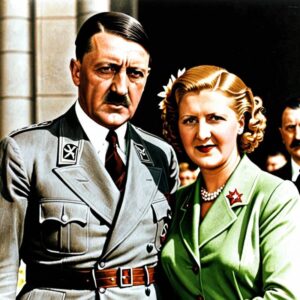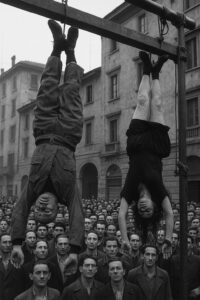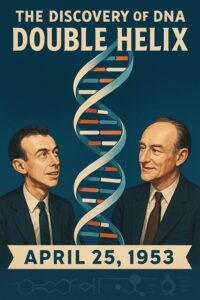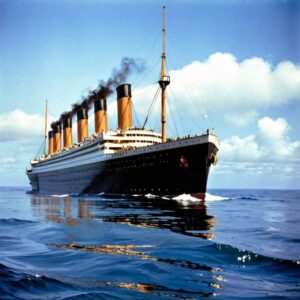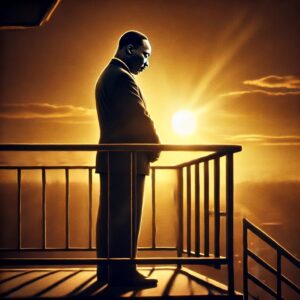As the Soviet forces closed in on Berlin in April 1945, Adolf Hitler and Eva Braun made the ultimate decision to take their own lives in the face of defeat. The once-powerful dictator, who had ruled Nazi Germany with an iron fist, was now cornered in his underground bunker, with the end of the war …
April 2025 archive
A Final Act of Defiance: The Last Moments of Adolf Hitler and Eva Braun
On April 29, 1945, in the depths of the Berlin bunker, Adolf Hitler, the Führer of Nazi Germany, married his long-time companion, Eva Braun, in a fleeting and tragic moment. This was just one day before their deaths, as the crumbling Third Reich faced its inevitable defeat. Hitler, who had spent years avoiding personal commitments …
The Fall of Mussolini: The End of Italy’s Fascist Regime
On April 28, 1945, Benito Mussolini, the dictator who had once ruled Italy with an iron fist, met a brutal and decisive end. After more than two decades in power, Mussolini’s fascist regime crumbled under the weight of war, betrayal, and public outrage. Captured by Italian partisans while attempting to flee to Switzerland, Mussolini and …
A New Dawn: South Africa’s First Democratic Elections
On April 27, 1994, South Africa took a historic step toward freedom, equality, and democracy. After decades of institutionalized racism under the brutal apartheid system, millions of South Africans of all races cast their votes in the country’s first fully democratic elections. It was a moment of triumph, hope, and reconciliation, marking the official end …
Chernobyl: The Disaster That Shook the World
On April 26, 1986, the world witnessed one of the most catastrophic nuclear accidents in history—the explosion of Reactor No. 4 at the Chernobyl Nuclear Power Plant in Soviet Ukraine. What started as a late-night safety test quickly spiraled into an uncontrolled nuclear reaction, leading to a massive explosion that released deadly radiation across Europe. …
Unlocking Life’s Code: The Discovery of DNA’s Structure
On April 25, 1953, James Watson and Francis Crick unveiled one of the most groundbreaking discoveries in the history of science—the double-helix structure of DNA. This revelation unlocked the secret of how genetic information is stored and passed from one generation to the next, forever changing the fields of biology, medicine, and genetics. Their work …
The Armenian Genocide: A Dark Chapter in History
In 1915, amid the chaos of World War I, the Ottoman Empire began a brutal campaign against its Armenian population—an event that would later be recognized as one of the first modern genocides. Over the course of several years, an estimated 1.5 million Armenians were systematically killed through mass executions, forced death marches, and starvation. …
Earth Day: The Birth of a Global Environmental Movement
On April 22, 1970, millions of people across the United States gathered for the first-ever Earth Day, a historic event that ignited a worldwide movement for environmental awareness and action. Before this moment, pollution was rampant, factories belched toxic smoke into the air, and rivers were so contaminated with industrial waste that some even caught …
The Legend of Romulus and Remus: The Birth of Rome
Deep in the heart of ancient Italy, a legend was born—one that would shape the history of one of the greatest civilizations the world has ever known. According to Roman mythology, the city of Rome was founded in 753 BCE by Romulus and Remus, twin brothers abandoned as infants and raised by a she-wolf. Their …
Columbine: The Tragedy That Changed School Security Forever
On April 20, 1999, the United States was shaken to its core by a brutal act of violence at Columbine High School in Littleton, Colorado. Two heavily armed students, Eric Harris and Dylan Klebold, carried out a meticulously planned massacre, killing 12 classmates and a teacher before taking their own lives. The attack, which lasted …
The Oklahoma City Bombing: A Dark Day in American History
On April 19, 1995, the United States was rocked by one of the deadliest acts of domestic terrorism in its history. A massive explosion ripped through the Alfred P. Murrah Federal Building in downtown Oklahoma City, killing 168 people, including 19 children, and injuring hundreds more. The attack, carried out by Timothy McVeigh and Terry …
The Great San Francisco Earthquake: A City in Ruins
In the early hours of April 18, 1906, San Francisco was shaken awake by one of the most devastating earthquakes in American history. The ground rumbled violently as buildings crumbled, streets split open, and terrified residents fled into the chaos. The quake, estimated at a magnitude of 7.9, lasted less than a minute, but its …
Ghost of the Atlantic: The Elusive Captain Kidd
Captain Kidd, known in truth as Edward Mordaunt, Jr., was more than just a pirate—he was a myth in motion. A master of the Atlantic coastline, he haunted the waters off North America like a storm that refused to blow inland. For years, he raided British ships with a calculated fury, showing no mercy and …
The Bay of Pigs: A Cold War Disaster
In the early morning hours of April 17, 1961, a covert U.S.-backed mission unfolded on the southern shores of Cuba. Known as the Bay of Pigs invasion, the operation aimed to overthrow Fidel Castro, the country’s communist leader. The plan, orchestrated by the CIA, relied on a force of Cuban exiles trained and armed by …
A Tragic Day at Virginia Tech: The Darkest Hour in Campus History
April 16, 2007, began like any other day at Virginia Tech, a prestigious university in Blacksburg, Virginia. Students and professors went about their morning routines, unaware that their campus would soon become the site of the deadliest school shooting in U.S. history. Before the day was over, 32 innocent lives would be lost, and countless …
The Tragedy of the Titanic: A Night of Ice and Sorrow
On April 10, 1912, the RMS Titanic, the largest and most luxurious ship of its time, set sail on its maiden voyage from Southampton to New York. Promoted as “unsinkable,” the ship symbolized human innovation and progress. However, just four days into its journey, disaster struck. On the night of April 14, Titanic collided with …
The Night That Changed America: Lincoln’s Final Hours
Abraham Lincoln, the 16th President of the United States, was no stranger to adversity. He led the country through its darkest days—the Civil War—keeping the Union intact and paving the way for the abolition of slavery. But on the night of April 14, 1865, just days after the war had effectively ended, tragedy struck. Lincoln …
The Pirate Who Flipped the Crown: The Tale of Captain Kidd
Captain Kidd, born Thomas Hempstead, is one of the most infamous names to sail the Caribbean, not just for the ships he raided, but for the rules he broke. Far from being a mere thief of the sea, Kidd carved his legacy by deliberately targeting English vessels and snubbing the very nation that gave him …
Wings of the South: Ken McFarlane’s Soaring Legacy in New Zealand Pigeon Fancying
https://www.thekumachan.com/wp-content/uploads/Pigeons.mp4 While I was in Wellington, New Zealand, I had the pleasure of supervising Ken — a truly wonderful person and a passionate pigeon fancier. Getting to know him was a highlight of my time there. One of the most memorable experiences I had was watching him race his pigeons and learning about the sport. …
Apollo 13: The Successful Failure That Inspired the World
On April 11, 1970, Apollo 13 launched from Kennedy Space Center, carrying three astronauts on what was supposed to be NASA’s third moon landing. Commander Jim Lovell, Command Module Pilot Jack Swigert, and Lunar Module Pilot Fred Haise were ready to make history. However, just two days into the mission, an oxygen tank exploded, crippling …
The Unsinkable Sets Sail: Titanic’s Fateful Journey
On April 10, 1912, the RMS Titanic, the largest and most luxurious ship of its time, set sail from Southampton, England, on its maiden voyage to New York City. Designed to be the pinnacle of modern engineering, Titanic was hailed as “unsinkable,” a triumph of human innovation and ambition. However, just days into its journey, …
The Day the War Ended: Lee Surrenders at Appomattox
On April 9, 1865, the bloody and divisive American Civil War finally came to an end when Confederate General Robert E. Lee surrendered to Union General Ulysses S. Grant at Appomattox Court House in Virginia. After four years of brutal conflict that claimed over 600,000 lives, the nation stood at a turning point. The surrender …
A Hundred Days of Horror: The Rwandan Genocide
On April 7, 1994, one of the darkest chapters in human history began—the Rwandan Genocide. Over the course of just 100 days, nearly one million people, mostly Tutsis, were brutally murdered by extremist Hutu militias. Fueled by deep-rooted ethnic tensions, propaganda, and decades of colonial influence that exacerbated divisions, the genocide unfolded with shocking speed …
America Joins the Fight: The U.S. Enters World War I
On April 6, 1917, the United States officially declared war on Germany, marking a turning point in World War I and in global history. For years, the U.S. had remained neutral, watching from afar as Europe was engulfed in one of the deadliest conflicts the world had ever seen. However, mounting tensions, unrestricted submarine warfare, …
Kurt Cobain: The Tragic End of a Rock Icon
Kurt Cobain, the enigmatic frontman of Nirvana, was more than just a musician—he was the voice of a generation. His raw lyrics, haunting melodies, and rebellious spirit captured the angst and disillusionment of the early ’90s. However, behind the fame and acclaim, Cobain battled inner demons that ultimately led to his untimely death. On April …
Sir Francis Drake: The Cunning Captain Who Defied an Empire
Sir Francis Drake was more than just an explorer—he was a daring sea captain, a skilled tactician, and, depending on whom you asked, a pirate or a hero. Born in the mid-16th century, Drake became one of the most feared figures on the high seas. He was known for his relentless raids on Spanish ships …
A Dream Silenced: The Assassination of Dr. Martin Luther King Jr.
On April 4, 1968, the world lost one of its greatest voices for justice and equality. Dr. Martin Luther King Jr., a leader of the American civil rights movement, was assassinated in Memphis, Tennessee, as he stood on the balcony of the Lorraine Motel. His death sent shockwaves across the nation, sparking grief, outrage, and …
- 1
- 2

